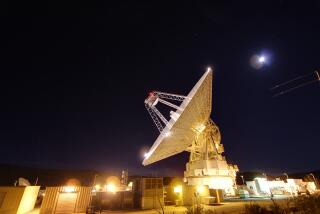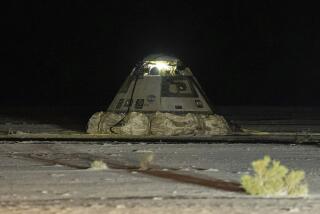What’s Going On?
Not many years ago you could guess with ease which superpower would have trouble mastering sophisticated technology and which would bring men back from space in triumph. Not this week.
On Tuesday the National Aeronautics and Space Administration announced still another failure in a test of a redesigned booster rocket of the kind that launches shuttles into space. On the same day, three cosmonauts returned to Earth from the Soviet Union’s space station Mir, one of them after a record 326 days of circling the Earth.
What’s going on here? Apparently it is up to Congress to find out, because the executive branch seems not to have the haziest notion.
Congress may not like what it finds, partly because some U.S. space failures result from NASA’s having to do with too little money--a common complaint in Washington and one that Congress can do little about, having too little money itself.
The most recent failure occurred during a test of a new booster rocket for space shuttles to replace one that ruptured during the launching nearly two years ago of Challenger, causing the death of seven astronauts. The new booster was built by Morton-Thiokol, Inc., the same company that built the booster involved in the Challenger disaster.
In the most recent test the rocket did not rupture, but part of a nozzle through which flames pour on liftoff fell apart. With more money NASA might have been able to contract with a second company to design a better booster rather than hope that Morton-Thiokol would correct its own flaw.
But it will take more than money to cure what ails NASA. And what ails it is partly a failure of imagination.
The shuttle is boosted into space by solid-fuel rockets that were designed originally to meet the special needs of nuclear missiles--the most important being that they can be launched virtually without warning while liquid-fueled rockets can require hours to prepare for launching.
Solid-fuel rockets are more temperamental and accident-prone, but the military was willing to trade some margin of safety for speed. Split-second launches are not required for shuttle missions, whose times of launching can be set months in advance. Yet there is no sign that NASA gave consideration to moving to cheaper and more stable liquid boosters, even after the Challenger tragedy.
On a grander scale, NASA seems to have lost its sense of mission and purpose. A blueprint for the future of NASA that touched every base--science, politics, psychology--was turned in by astronaut Sally Ride as her last assignment before leaving the agency to work at arms control. It has vanished, possibly into the same warehouse that is filling up with other pleas to breathe life back into America’s space program.
The bleakest appraisal of NASA goes like this: It is an immense and aging bureaucracy that was created to do one job and did it with spectacular results--getting Americans to the moon and back. Having performed that dazzling mission, it cannot be galvanized by the lesser mission of what is in effect a trucking business in space any more than a pedigreed hunting dog can be induced to think of chasing sticks as great sport.
Bureaucracies are complicated institutions, with personalities all their own. The bleak appraisal could be nonsense, or it could explain NASA’s lethargy and string of failures better than any attempt to be scientific about the decline of a probably once-great organization.
Because there is some urgency to the matter, Congress should consider reconvening the commission that examined the Challenger tragedy and giving it the broad charter that it should have had in the first place--to find out not just what was wrong with one booster but what is wrong with NASA. America’s future in space is in the balance.
More to Read
Sign up for Essential California
The most important California stories and recommendations in your inbox every morning.
You may occasionally receive promotional content from the Los Angeles Times.










